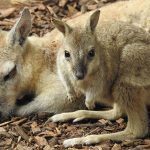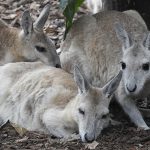NORTHERN NAIL-TAIL WALLABY
The Northern nail-tail wallaby: An Unsung Tale of Adaptation-
Imagine slipping through the golden light of Australia’s northern savannas as the sun slips away and the air cools gently. In this tranquil dusk, the Northern nail-tail wallaby moves quietly, alert to every sound—the far-off call of a Kookaburra, the brush of wind across brittle grass, the scent of distant rain carried on the breeze. This animal, though often overlooked, embodies a unique story of adaptation and resilience.
Unique Physical Wonders
- Nail-tail Mystery: That cartilaginous spur at the end of the tail, shaped like a crescent moon, is unlike anything found in most macropods. While its full purpose remains a mystery, researchers suspect it could play a role in social touch or perhaps defence.
- Remarkable Ears: Highly mobile, they can rotate independently, allowing the wallaby to catch the faintest rustle—essential for detecting both predators and friends.
- Eyes for the Night: Their large, reflective eyes allow them to see well in low-light conditions, using the soft blue hues of evening and early dawn to navigate.
Ecological Niche and Adaptations
- Nature’s Lawn Mower: By nibbling selectively on grasses and herbs, nail-tail wallabies help maintain the balance of plant species in the ecosystem, preventing any one type from dominating and encouraging biodiversity.
- Efficient Water Use: These wallabies seldom drink from open water. Instead, they obtain nearly all their moisture needs from dew on grass, succulent leaves, or even the root systems of certain plants during dry times.
- Dust Bath Rituals: Regularly, they use shallow patches of dusty earth for bathing, a behaviour that helps them control parasites and cool their skin.
Quiet Social Lives
- Communication: While mostly silent, Northern nail-tail wallabies can thump their feet against the ground to warn others of nearby danger—a vibration that travels through the earth more reliably than sound through foliage.
- Gentle Gatherings: On occasion, several wallabies will come together at a particularly rich feeding area, keeping a respectful distance from one another—a subtle, non-confrontational dance of coexistence.
- Scent Trails: Glands around their chest and head release subtle scents used for marking territory and identifying each other, an olfactory tapestry invisible to us but crucial for wallaby society.
From Birth to Independence
- Joey’s Journey: After birth, the blind and undeveloped joey must make its way unaided into the mother’s pouch—a journey equal parts peril and persistence. Inside, the pouch nurtures not only the infant but also provides a microclimate, sheltering it from heat, cold, and dry winds.
- Long-term Care: Even after leaving the pouch, the joey will return to nurse, occasionally sharing space comfortably with a younger sibling—a remarkable adaptation in marsupials known as
embryonic diapause, where one embryo pauses development until the pouch becomes available.
Challenges and Conservation
Threats
| Threat | Impact |
|---|---|
| Predation | Introduced predators such as foxes, cats, and dogs are major threats, particularly to juveniles. |
| Habitat Destruction | Land clearing for agriculture or urban growth fragments populations, reducing genetic diversity. |
| Altered Fire Patterns | Increased frequency or intensity of fires can remove sheltering shrubs, exposing wallabies to danger and reducing food. |
| Competition | Feral rabbits and livestock consume key food plants, leaving less for the wallabies. |
Conservation Steps
- Predator Management: Efforts focus on controlling introduced predators in key habitats.
- Habitat Restoration: Protecting and restoring native grasslands ensures future generations have homes.
- Fire Management: Thoughtful fire regime practices mimic natural cycles, enabling grasses to regenerate without destroying shelter.
An Invitation to Care
Walking in the evening quiet, we might never know the full world of the Northern nail-tail wallaby—the soft thud of its leap, the warmth of its sun-baked fur, the sharp joy of grasses after rain. But by learning, appreciating, and acting to conserve, we become part of their story—a gentle ripple in the living tapestry of Australia’s wild heart.
| Feature | Details |
|---|---|
| Scientific Name | Onychogalea unguifera |
| Typical Lifespan | Approximately 6–8 years in the wild |
| Activity | Mainly nocturnal and crepuscular |
| Diet | Grasses, herbs, some roots and succulent vegetation |
| Population Trend | Declining but present in select reserves |
In the fragile hush between daylight and darkness, the Northern nail-tail wallaby persists—a living testament to Australia’s wild resilience, awaiting our respect and protection.












